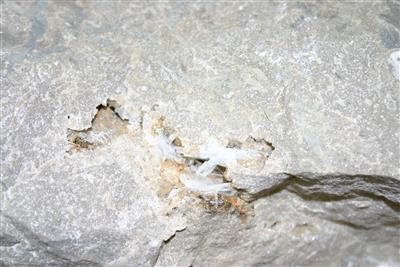
Credit: Courtesy of John Luczaj
January 14, 2014
By Marie Zhuikov
University of Wisconsin Water Resources Institute researchers have discovered strontium in the drinking water of people living in Brown and Outagamie counties near Green Bay, Wis. Not to be confused with the radioactive version that is a byproduct of nuclear fission, this type of strontium is contained within a mineral known as celestine. Strontium dissolves in water and has no taste or odor, and can cause health problems when ingested, especially for children.
The study, by John Luczaj, associate professor in the Department of Natural and Applied Sciences at the University of Wisconsin-Green Bay with UW-Green Bay graduate student Joseph Baeten and Associate Professor Michael Zorn, involved collecting 115 water samples from municipal and private wells in Brown and Outagamie counties.
In preliminary findings, 73 samples (63 percent) contained strontium levels higher than the Environmental Protection Agency’s lifetime Health Advisory Limit of 4 mg/L, which means people drinking the water over the long term face an increased risk for health problems. Six water samples (5 percent) contained levels above 25 mg/L, which exceed the short-term exposure levels identified by the EPA. Children who drink the water for more than between one and 10 days face an increased risk of developing health problems, including tooth enamel mottling and strontium rickets.
The researchers also pinpointed that the source of the strontium is natural. In addition to the water samples analyzed, they examined the chemistry of over 100 rock samples collected during other studies. Their analysis showed the primary source of dissolved strontium in the groundwater originates from celestine and possibly strontianite, another mineral.

Credit: Courtesy of John Luczaj
“Our study confirms there’s a significant problem in eastern Wisconsin for strontium levels in drinking water,” Luczaj said. “The public needs to be aware of this, and we recommend that a Strontium Advisory Area be established for the region.”
Roy Irving, a toxicologist with the Wisconsin Department of Health Services, said, “It would make sense that the researchers would recommend testing if they could identify an area that was susceptible to high levels of naturally occurring strontium. For example, when a high percentage of wells in Outagamie and Winnebago counties tested above state standards for arsenic, an “arsenic advisory area” was identified. Residents were advised to test annually for arsenic and new wells were designed differently to minimize the risk of arsenic in drinking water. If the strontium studies provide the same level of information, a similar approach could be used,” Irving said. In the interim, he advises well owners to use tools like the online well water quality viewer or consult with a licensed well driller or pump installer to determine needed testing in their area.
On the periodic table, strontium’s upper and lower neighbors are calcium and barium. Strontium’s similarity to calcium and its behavior in water is what makes this mineral problematic for humans, especially children.
“When children’s tooth enamel and bones are developing, exposure to strontium can cause tooth mottling and strontium rickets,” said Luczaj.
While tooth mottling is mainly a cosmetic issue, causing white spots or brown stains to be deposited on the teeth, rickets can impact bone development and quality of life. The body mistakes strontium for calcium and tries to incorporate it into developing bones. This softens the bones, leading to bowed legs, widened wrists, skull abnormalities, spinal deformities, and an increased likelihood for bone fractures.
According to the Outagamie County Public Health Division, rickets is not a reportable illness, so data on its prevalence is not available.
Although evaluating the distribution and sources of strontium in Brown and Outagamie counties was the focus of the study, the researchers also tested several household samples of water treated with water softeners and found them effective at removing 97 percent of the dissolved strontium. Municipal systems were less effective in removing strontium because they are designed to remove radium. In two municipal samples, 57 percent and 74 percent of strontium were removed.
Luczaj has these suggestions for people in the counties with high strontium: “If they are drinking water-softened water or reverse-osmosis water, there’s probably little strontium in it,” he said. “But if they have young children and they are in the high-strontium area, they should definitely have their water tested.”
Luczaj says testing for strontium costs between $30 and $75, depending on what other chemicals people want included in the test. To find a state-certified water testing laboratory, search the lab lists on the Wisconsin Department of Natural Resources website.
To learn more, read the Wisconsin Department of Health Service’s “Strontium in Drinking Water” fact sheet.
Since the 1950s, John Luczaj said people knew there was a significant amount of strontium in the water; however, the issue fell by the scientific wayside.
Luczaj credits Dave Johnson, a hydrogeologist with the Wisconsin Department of Natural Resources for resurrecting the investigation. Johnson credits Dennis Rohr, a science teacher at Seymour High School. Rohr credits Michael Hanton, general manager with Clean Water Testing in Appleton.
In 2007, Rohr and his high school science club students were awarded a prestigious Toyota TAPESTRY grant to study the connection between 23 heavy metals that found in well water along with naturally occurring arsenic, a known contaminant in the area. “Often, other heavy metals increase when you have increasing amounts of arsenic in the water,” Rohr said. He worked with Hanton’s company, which provided professional testing of the water samples.
“Hanton had tested water in Brown County and suggested we get samples from there, and that’s where we discovered the high levels of strontium,” Rohr said. “It was our grant that found it, but it was Hanton’s insight that led us to it. I really can’t take credit for it,” Rohr said.
In the meantime, Johnson had seen the mineral celestine in local quarries and heard about strontium levels in water in conversations with Rohr. “Then Luczaj came to me looking for an issue that needed research. I suggested he look at strontium and told him about Rohr’s findings. I didn’t do anything other than that,” Johnson said.
Whoever’s idea it was, the project turned out to offer valuable insight into Wisconsin’s water quality.



